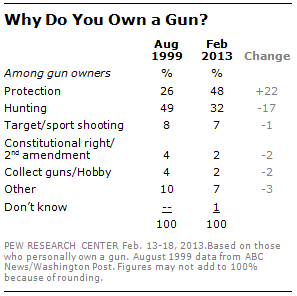The following is a chapter from Money, Sex, Power & Faith.
Order your copy in paperback or for Kindle!
While war is certainly big business, and the plethora of 24-hour news stations earn quite a bit of advertising revenue from stories of violence, the truth is that violence, both at war and on the homefront, is on a downward trend. Over the last few decades, the majority of developed nations have reported a significant decline in homicide and violent crimes. According to FBI publications, in the United States, the rate of violent crime fell 48% from 1993 to 2016. A Bureau of Justice report claims that in that same time span, the rate fell by 74%. And according the a survey by the Pew Research Center, the last peak of gun related homicides was in 1993, and firearm homicides were 49% lower in 2010 while assaults, robberies, and sex crimes were down by 75%.
Yet, the Pew Research Center also reports that in spite of the fact that people are killing each other less, 56% of Americans believe that gun crime is higher now than it was twenty years ago, and only 12% think it is actually lower. Of course, although gun deaths have gone down, it is still estimated that Americans are twenty-five times more likely to be killed by a gun than other high income nations.
According to a study in The American Journal of Medicine, although the United States has half the population of the 22 other high income nations combined, it accounted for 82% of all gun-related deaths, including 90% of women killed by guns, 91% of gunshot victims under the age of fourteen, and 92% of people killed by guns between the ages of fifteen and twenty-four. Of course, this could be due to the number of guns that America owns.
Although the United States represents only 5% of the human population, it is estimated that they own 35-50% of the guns. Yet that does not mean that more Americans are buying guns. As a matter of fact, gun ownership in America has decreased from a high of 54% in 1977 to 32% in 2014. However, the number of guns per owner has increased significantly.
The Congressional Research Service reports that the number of guns per capita doubled between 1968 and 2009, and there are currently about 101 guns for every 100 US citizens. However, half of them are owned by only 3% of the population, according to a study by Harvard and Northeastern University, which found that an estimated 7.7 million Americans own between eight and 140 guns each.
Gun enthusiasts are quick to point out that the rise in guns per capita correlates directly with the decline in gun-related deaths, however, America is still the leader in gun-related deaths among developed nations. While half of the world’s gun homicides occur in only twenty countries, all of them in Latin America or sub-Saharan Africa, each with far fewer guns per capita than the United States, according to a study by the University of Washington’s Institute for Health Metrics and Evaluation, in 2016, the US had the 31st highest rate of gun violence in the world, with 3.86 gun-related deaths per 100,000 people. While that is much lower than El Salvador, which has the most with 40.29 gun-related deaths per 100,000 with only 5.8 guns per 100 people, or Venezuela, which has 34.77 gun-related deaths per 100,000 people with only 10.7 guns per 100 people, the rate of gun deaths in the US was eight times the rate in Canada and twenty-seven times the rate of Denmark.
Of course, Canada only has about thirty-three guns per 100 people, and Denmark only has twelve guns per 100 people. Nevertheless, given its socioeconomic status, the IHME estimates that the US should only be seeing .79 deaths per 100,000. Generally, richer countries are less violent, yet America seems intent on breaking the mold.
According to the Centers for Disease Control and Prevention, there have been 1,396,733 American deaths attributed to war since its founding, and 1,516,863 gun-related deaths on US soil since 1968. The International Journal of Criminal Justice Sciences reports that the United States also has eleven times the number of mass shootings as other nations. As mass shootings increase in the United States, many try to raise the issue of gun control, yet many others say that it is too soon after the tragedy to discuss it.
Generally, when the 32% of the population who do own guns are pressed about the possibility of enacting more common sense gun laws, they are quick to point out that the Second Amendment gives them the “right to bear arms,“ and as many as they want. However, the Second Amendment has twenty-seven words, and although those four are important, the first four, “a well regulated militia,” are possibly even more important, yet they are rarely, if ever, discussed. Those asking for regulations like raising the age to buy guns to twenty-one, banning the sale of fully and semi-automatic weapons and equipment, and mandatory background checks, still never ask how people are regulating their militia? It certainly has proven to be a challenging thing to regulate a militia well when we’re not allowed to enact any regulations.
 Thomas Jefferson once said,”The strongest reason for people to retain the right to keep and bear arms is, as a last resort, to protect themselves against tyranny in government,” however that’s not why most Americans claim to own guns. A 2013 survey by the Pew Research Center found that 48% say they have a gun for protection, compared to 26% who said they owned a gun for protection in 1999, when crime rates were higher. Only 32% say they have a gun for hunting and recreation, compared to 49% who were sport shooters in 1999. Although the world is indeed getting less violent, the American people do not seem to think so.
Thomas Jefferson once said,”The strongest reason for people to retain the right to keep and bear arms is, as a last resort, to protect themselves against tyranny in government,” however that’s not why most Americans claim to own guns. A 2013 survey by the Pew Research Center found that 48% say they have a gun for protection, compared to 26% who said they owned a gun for protection in 1999, when crime rates were higher. Only 32% say they have a gun for hunting and recreation, compared to 49% who were sport shooters in 1999. Although the world is indeed getting less violent, the American people do not seem to think so.
Yet while having a gun for self-defense is perfectly understandable, they are rarely used for such a purpose. The Journal of Trauma, Injury, Infection and Critical Care reports that for every one time that a gun is used in self-defense, four are involved in unintentional shootings, seven are used in assaults or homicides, and eleven are used for suicides. The FBI reports that in 2016, 73% of all murders in the United States involved a gun, the highest on record, and more than 60% of the people who die from guns in America are victims of suicide.
Suicide is the tenth most common cause of death in the country, and the second-most cause of death for Americans between the ages of fifteen and thirty-four. While the United States has 3.86 gun-related deaths per 100,000 people, it has 19.5 suicides, according to the World Health Organization. That doesn’t make the US that much different than the rest of the world, however it is higher than the average rate of 10.7 per 100,000.
The World Health Organization reports that although rates of gun violence may have declined over the last few decades, suicide rates have increased 60% worldwide over the last forty-five years. Suicide now accounts for more than half of all violent deaths in the world, accounting for more than wars and homicides combined. While 78% of suicides are reported in lower income countries, those in developed countries are certainly not immune to it.
The challenge for America is that gun control regulations are always decided upon by representatives of the republic instead of democratically by the people. In the 2016 election cycle, gun rights organizations represented almost 55 million dollars in outside spending, with 5.9 million going directly to Republican candidates and with 106,000$ going to Democratic candidates. Yet although an estimated 82% of Americans want more common sense gun regulations, outside spending from gun control groups was only 3 million dollars in the same cycle. This decision should not be made by money, but by the people who wish to practice their constitutional right to regulate their militia.
Order your copy of Money, Sex, Power & Faith today!



Pingback: [BLOCKED BY STBV] Will Rogers and Fake News